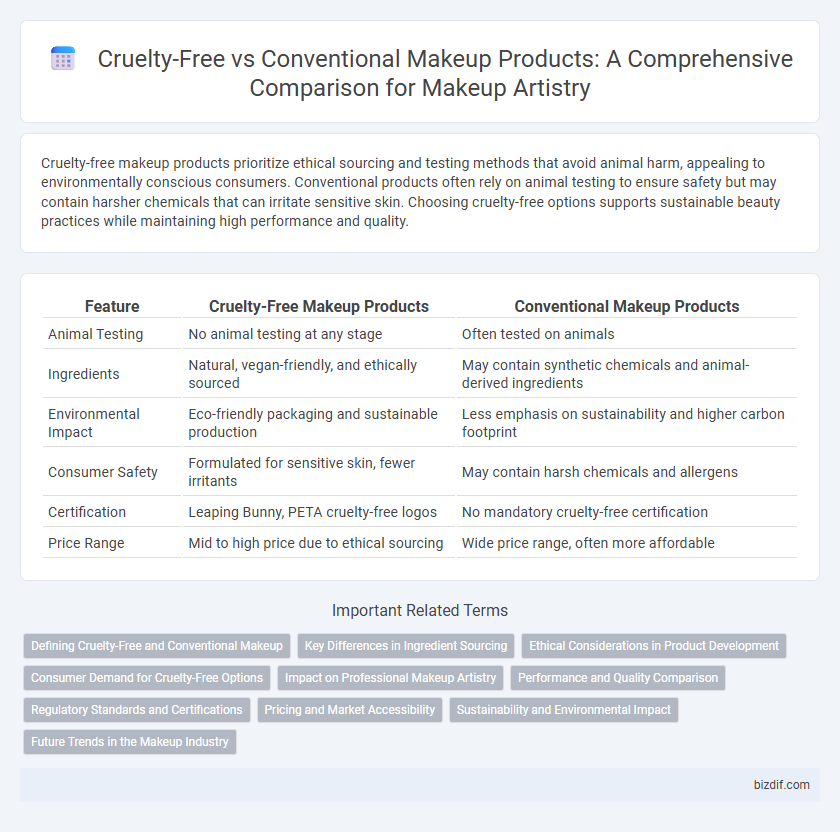Cruelty-free makeup products prioritize ethical sourcing and testing methods that avoid animal harm, appealing to environmentally conscious consumers. Conventional products often rely on animal testing to ensure safety but may contain harsher chemicals that can irritate sensitive skin. Choosing cruelty-free options supports sustainable beauty practices while maintaining high performance and quality.
Table of Comparison
| Feature | Cruelty-Free Makeup Products | Conventional Makeup Products |
|---|---|---|
| Animal Testing | No animal testing at any stage | Often tested on animals |
| Ingredients | Natural, vegan-friendly, and ethically sourced | May contain synthetic chemicals and animal-derived ingredients |
| Environmental Impact | Eco-friendly packaging and sustainable production | Less emphasis on sustainability and higher carbon footprint |
| Consumer Safety | Formulated for sensitive skin, fewer irritants | May contain harsh chemicals and allergens |
| Certification | Leaping Bunny, PETA cruelty-free logos | No mandatory cruelty-free certification |
| Price Range | Mid to high price due to ethical sourcing | Wide price range, often more affordable |
Defining Cruelty-Free and Conventional Makeup
Cruelty-free makeup products are formulated and tested without any involvement of animal testing at any stage, adhering to ethical standards that prioritize animal welfare. Conventional makeup products often include ingredients tested on animals or sourced from animal byproducts, raising concerns about environmental impact and animal cruelty. The distinction lies in cruelty-free brands' commitment to transparent sourcing and safe, non-animal tested ingredients compared to traditional brands with less regulated testing protocols.
Key Differences in Ingredient Sourcing
Cruelty-free makeup products often prioritize ethically sourced, plant-based ingredients, avoiding animal testing and synthetic chemicals that may harm ecosystems. Conventional products typically include petroleum-derived substances and animal by-products, sourced through processes that may involve environmental degradation and animal exploitation. Ingredient transparency and sustainability are key factors distinguishing cruelty-free brands from traditional cosmetics manufacturers.
Ethical Considerations in Product Development
Cruelty-free makeup products prioritize ethical considerations by eliminating animal testing, promoting humane research methods, and supporting sustainable sourcing of ingredients. Conventional products often rely on animal experiments for safety validation, raising concerns about animal welfare and environmental impact during production. Embracing cruelty-free formulations aligns with growing consumer demand for transparent, socially responsible beauty brands that minimize harm to animals and ecosystems.
Consumer Demand for Cruelty-Free Options
Consumer demand for cruelty-free makeup products has surged as ethical concerns and animal welfare awareness grow globally. Cruelty-free cosmetics, formulated without animal testing, attract a conscientious audience seeking transparency, sustainability, and non-toxic ingredients. This shift pressures conventional brands to innovate and adopt cruelty-free certifications to maintain market relevance and consumer loyalty.
Impact on Professional Makeup Artistry
Cruelty-free makeup products have reshaped professional makeup artistry by emphasizing ethical beauty, attracting clients who prioritize animal welfare and sustainability. These products often feature natural ingredients and innovative formulations that reduce skin irritation, enhancing the overall client experience and satisfaction. In contrast, conventional products may offer a wider range of pigment options and long-lasting formulas but face increasing scrutiny over ethical concerns and environmental impact.
Performance and Quality Comparison
Cruelty-free makeup products often match conventional products in performance and quality, offering vibrant pigmentation, long-lasting wear, and smooth application without animal testing. Many cruelty-free brands utilize innovative ingredients that provide comparable coverage, blendability, and skin benefits, dispelling the myth that ethical formulations compromise effectiveness. Consumers increasingly recognize that cruelty-free options deliver professional-grade results while supporting ethical beauty standards.
Regulatory Standards and Certifications
Cruelty-free makeup products adhere to strict regulatory standards that prohibit animal testing, often certified by organizations like Leaping Bunny or PETA's Beauty Without Bunnies program. Conventional products may comply with general cosmetic safety regulations but frequently lack certifications ensuring no animal testing or ethical ingredient sourcing. Regulatory frameworks such as the EU Cosmetics Regulation enforce bans on animal-tested cosmetics, differentiating cruelty-free labels from conventional product claims worldwide.
Pricing and Market Accessibility
Cruelty-free makeup products typically command higher prices due to ethical sourcing and certification costs, limiting market accessibility for budget-conscious consumers. Conventional makeup products benefit from mass production and widespread retail availability, making them more affordable and easier to access across diverse markets. The growing consumer demand for cruelty-free options is gradually driving price competitiveness and broader distribution channels in the beauty industry.
Sustainability and Environmental Impact
Cruelty-free makeup products prioritize sustainability by eliminating animal testing and often incorporate eco-friendly ingredients and packaging, reducing environmental pollution compared to conventional products. Conventional makeup products frequently rely on synthetic chemicals and animal-derived components, which contribute to habitat destruction and chemical waste. Choosing cruelty-free options supports biodiversity preservation and promotes ethical consumption within the beauty industry.
Future Trends in the Makeup Industry
Cruelty-free makeup products are rapidly gaining market share as consumers increasingly prioritize ethical sourcing and animal welfare, driving innovation in vegan formulas and biodegradable packaging. Advancements in biotechnology and sustainable ingredients are set to disrupt conventional product lines, reducing reliance on synthetic chemicals and harmful testing methods. Emerging regulations and brand transparency will further accelerate the shift towards cruelty-free standards, shaping the future makeup industry's sustainability and ethical benchmarks.
Cruelty-free products vs Conventional products Infographic

 bizdif.com
bizdif.com